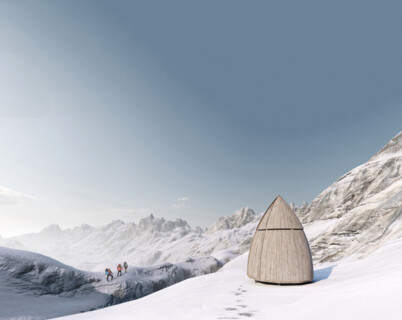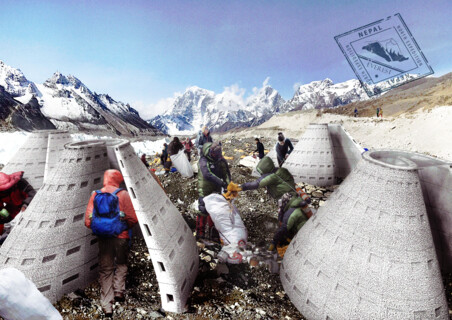- wa-ID
- wa-2032109
- Tag der Veröffentlichung
- 06.07.2021
- Aktualisiert am
- 29.03.2022
- Verfahrensart
- Offener Wettbewerb
- Zulassungsbereich
-
Andere
- Teilnehmer
- Keine Teilnahmebeschränkungen
- Auslober
- Buildner Architecture Competitions
- Bewerbungsschluss
- 15.11.2021
- Abgabetermin
- 17.12.2021
- Bekanntgabe
- 01.03.2022
Verfahrensart
Offener Ideenwettbewerb
Wettbewerbsaufgabe
Die globale Klimakrise hat die Auswirkungen des Bauwesens und der Architektur auf die Umwelt und die Bedeutung von bescheidenen, aber durchdachten Entwürfen, die das Leben der Nutzer verbessern und ihre Umgebung respektvoll behandeln, deutlich gemacht.
Die Kultur der egozentrischen Architektur wird jedoch schnell zu einem Problem in unserem Beruf. Der Wunsch eines Architekten, nur durch glitzernde und pompöse Fassaden aufzufallen und dabei die wirklichen, versteckten Designherausforderungen zu vernachlässigen, ist nicht das, was die Welt im Moment braucht.
Deshalb hat Bee Breeders die Wettbewerbsreihe Humble Architecture ins Leben gerufen. Jeder Ideenwettbewerb dieser Reihe ist an einem anderen weltberühmten Ort angesiedelt und versucht, ein Problem zu lösen, das für alle diese Orte gilt - das Badezimmer. Das Design von Toiletten ist normalerweise nichts, was auf den ersten Seiten eines Portfolios zu finden ist. Wir glauben jedoch, dass diese Herausforderungen viel komplexer sein können, als sie auf den ersten Blick erscheinen, und dass ihre Lösung unerwartet lohnend sein kann.
Humble Architecture: Everest Challenge
Der höchste Berg der Welt, der Mount Everest, ist seit langem ein beliebtes Touristenziel, aber die Umweltauswirkungen, die dadurch entstehen, dass Wanderer keine Möglichkeit haben, sich zu erleichtern, sind ein echtes Problem. Menschliche Ausscheidungen können den Schnee verunreinigen und sogar über die Luft übertragen werden und bei anderen Reisenden und Einheimischen Krankheiten verursachen. Ganz zu schweigen von der unangenehmen Tatsache, dass man bei fast jedem Schritt in Exkremente tritt.
Aus diesem Grund werden Touristen von den lokalen Gemeinschaften nicht immer gern gesehen, und die durch den Tourismus verursachten Schäden könnten die wirtschaftlichen Vorteile des Tourismus zunichte machen, insbesondere in gefährdeten Gebieten.
Bei der Humble Architecture: Everest Challenge haben die Teilnehmer die Aufgabe, nachhaltige Toilettenanlagen auf dem Mount Everest zu entwerfen, die sich nahtlos in die Umgebung einfügen. Auf dem Everest gibt es, wenn überhaupt, nur wenige Toilettenanlagen jenseits des Basislagers. Daher können die Teilnehmer diesen Wettbewerb als Instrument nutzen, um bestehende Anlagen zu kritisieren oder völlig neue zu entwerfen.
Competition assignment
The global climate crisis has highlighted the impact of construction and architecture on the environment, and the importance of humble but thoughtful designs that would improve the lives of users and treat their surroundings with respect.
However, a culture of ego-driven architecture is quickly becoming a problem in our profession. An architect’s desire to be noticed only for glitzy and pompous facades, often neglecting the real, hidden design challenges, is not what the world needs right now.
Therefore, Bee Breeders has launched its Humble Architecture competition series. Each ideas competition in the series is set in a different world-famous location and seeks to solve a problem universal to all of them - bathrooms. Toilet design is not usually something that would be featured in the front pages of your portfolio, however, we believe these challenges can be much more complex than they first appear, and solving them can be unexpectedly rewarding.
Humble Architecture: Everest Challenge
The world’s tallest mountain, Mount Everest, has long been a popular tourist destination, but the environmental impact of trekkers not having a place to relieve themselves is causing a real problem. Human waste particles can contaminate the snow, and even become airborne and cause illness in other travelers and locals. Not to mention the unpleasant fact that almost every step you take will have you stepping in excrement.
Because of this, tourists are not always thought of fondly by local communities, and the damage caused by tourism could end up negating the economic benefits of it, especially in vulnerable areas.
For the Humble Architecture: Everest Challenge, participants are tasked with designing sustainable toilet facilities on Mount Everest that seamlessly blend into the environment. There are few, if any, toilet facilities on Everest past Base Camp, and therefore participants can choose to use this competition as a tool to critique existing facilities or to design completely new ones.
Jury
Diego Baraona, founder of the Chilean architecture office DBAA - Diego Baraona Arquitectos y Asociados
Martin Beverfjord, co-founder of Oslo-based Rever & Drage, whose portfolio includes a triangular, aluminum toilet near the Farstadsanden beach on the west coast of Norway on one of the country's national scenic tourist routes
Greg Corso of Syracuse NY-based SPORTS Collaborative and Assistant Professor at Syracuse University, School of Architecture
Gonçalo Marrote, an architect and CEO at Madeiguincho, based in Cascais, Portugal and known for its merger of carpentry, architecture and art
Stephen Pimbley, the founding director of SPARK Architects, which has developed an easily transportable 3d printed toilet module in support of the UN initiative to combat open defecation and the associated issues of hygiene and sanitation in India
Angelo Renna, an architect that recently published the book Monkey Factor – Small stories for a reconciliation with nature
Erik “Rick” Sommerfeld, an Architect, Assistant Professor and the Director of ColoradoBuildingWorkshop, the design-build program at the University of Colorado Denver, which annually designs and constructs a small-scale project such as that for a toilet in Rocky Mountain National Park
Weitere Informationen zu den Gewinnern finden Sie unter /
More information about the winners can be found at:
architecturecompetitions.com/humbleeverest/
Offener Ideenwettbewerb
Wettbewerbsaufgabe
Die globale Klimakrise hat die Auswirkungen des Bauwesens und der Architektur auf die Umwelt und die Bedeutung von bescheidenen, aber durchdachten Entwürfen, die das Leben der Nutzer verbessern und ihre Umgebung respektvoll behandeln, deutlich gemacht.
Die Kultur der egozentrischen Architektur wird jedoch schnell zu einem Problem in unserem Beruf. Der Wunsch eines Architekten, nur durch glitzernde und pompöse Fassaden aufzufallen und dabei die wirklichen, versteckten Designherausforderungen zu vernachlässigen, ist nicht das, was die Welt im Moment braucht.
Deshalb hat Bee Breeders die Wettbewerbsreihe Humble Architecture ins Leben gerufen. Jeder Ideenwettbewerb dieser Reihe ist an einem anderen weltberühmten Ort angesiedelt und versucht, ein Problem zu lösen, das für alle diese Orte gilt - das Badezimmer. Das Design von Toiletten ist normalerweise nichts, was auf den ersten Seiten eines Portfolios zu finden ist. Wir glauben jedoch, dass diese Herausforderungen viel komplexer sein können, als sie auf den ersten Blick erscheinen, und dass ihre Lösung unerwartet lohnend sein kann.
Humble Architecture: Everest Challenge
Der höchste Berg der Welt, der Mount Everest, ist seit langem ein beliebtes Touristenziel, aber die Umweltauswirkungen, die dadurch entstehen, dass Wanderer keine Möglichkeit haben, sich zu erleichtern, sind ein echtes Problem. Menschliche Ausscheidungen können den Schnee verunreinigen und sogar über die Luft übertragen werden und bei anderen Reisenden und Einheimischen Krankheiten verursachen. Ganz zu schweigen von der unangenehmen Tatsache, dass man bei fast jedem Schritt in Exkremente tritt.
Aus diesem Grund werden Touristen von den lokalen Gemeinschaften nicht immer gern gesehen, und die durch den Tourismus verursachten Schäden könnten die wirtschaftlichen Vorteile des Tourismus zunichte machen, insbesondere in gefährdeten Gebieten.
Bei der Humble Architecture: Everest Challenge haben die Teilnehmer die Aufgabe, nachhaltige Toilettenanlagen auf dem Mount Everest zu entwerfen, die sich nahtlos in die Umgebung einfügen. Auf dem Everest gibt es, wenn überhaupt, nur wenige Toilettenanlagen jenseits des Basislagers. Daher können die Teilnehmer diesen Wettbewerb als Instrument nutzen, um bestehende Anlagen zu kritisieren oder völlig neue zu entwerfen.
Competition assignment
The global climate crisis has highlighted the impact of construction and architecture on the environment, and the importance of humble but thoughtful designs that would improve the lives of users and treat their surroundings with respect.
However, a culture of ego-driven architecture is quickly becoming a problem in our profession. An architect’s desire to be noticed only for glitzy and pompous facades, often neglecting the real, hidden design challenges, is not what the world needs right now.
Therefore, Bee Breeders has launched its Humble Architecture competition series. Each ideas competition in the series is set in a different world-famous location and seeks to solve a problem universal to all of them - bathrooms. Toilet design is not usually something that would be featured in the front pages of your portfolio, however, we believe these challenges can be much more complex than they first appear, and solving them can be unexpectedly rewarding.
Humble Architecture: Everest Challenge
The world’s tallest mountain, Mount Everest, has long been a popular tourist destination, but the environmental impact of trekkers not having a place to relieve themselves is causing a real problem. Human waste particles can contaminate the snow, and even become airborne and cause illness in other travelers and locals. Not to mention the unpleasant fact that almost every step you take will have you stepping in excrement.
Because of this, tourists are not always thought of fondly by local communities, and the damage caused by tourism could end up negating the economic benefits of it, especially in vulnerable areas.
For the Humble Architecture: Everest Challenge, participants are tasked with designing sustainable toilet facilities on Mount Everest that seamlessly blend into the environment. There are few, if any, toilet facilities on Everest past Base Camp, and therefore participants can choose to use this competition as a tool to critique existing facilities or to design completely new ones.
Jury
Diego Baraona, founder of the Chilean architecture office DBAA - Diego Baraona Arquitectos y Asociados
Martin Beverfjord, co-founder of Oslo-based Rever & Drage, whose portfolio includes a triangular, aluminum toilet near the Farstadsanden beach on the west coast of Norway on one of the country's national scenic tourist routes
Greg Corso of Syracuse NY-based SPORTS Collaborative and Assistant Professor at Syracuse University, School of Architecture
Gonçalo Marrote, an architect and CEO at Madeiguincho, based in Cascais, Portugal and known for its merger of carpentry, architecture and art
Stephen Pimbley, the founding director of SPARK Architects, which has developed an easily transportable 3d printed toilet module in support of the UN initiative to combat open defecation and the associated issues of hygiene and sanitation in India
Angelo Renna, an architect that recently published the book Monkey Factor – Small stories for a reconciliation with nature
Erik “Rick” Sommerfeld, an Architect, Assistant Professor and the Director of ColoradoBuildingWorkshop, the design-build program at the University of Colorado Denver, which annually designs and constructs a small-scale project such as that for a toilet in Rocky Mountain National Park
Weitere Informationen zu den Gewinnern finden Sie unter /
More information about the winners can be found at:
architecturecompetitions.com/humbleeverest/
Humble Architecture: Everest Challenge
Organizers
Bee Breeders
Architecture Competition Organisers
About the Competition
The global climate crisis has highlighted the impact of construction and architecture on the environment, and the importance of humble but thoughtful designs that would improve the lives of users and treat their surroundings with respect.
However, a culture of ego-driven architecture is quickly becoming a problem in our profession. An architect’s desire to be noticed only for glitzy and pompous facades, often neglecting the real, hidden design challenges, is not what the world needs right now.
Therefore, Bee Breeders has launched its Humble Architecture competition series. Each ideas competition in the series is set in a different world-famous location and seeks to solve a problem universal to all of them - bathrooms. Toilet design is not usually something that would be featured in the front pages of your portfolio, however, we believe these challenges can be much more complex than they first appear, and solving them can be unexpectedly rewarding.
Humble Architecture: Everest Challenge
The world’s tallest mountain, Mount Everest, has long been a popular tourist destination, but the environmental impact of trekkers not having a place to relieve themselves is causing a real problem. Human waste particles can contaminate the snow, and even become airborne and cause illness in other travelers and locals. Not to mention the unpleasant fact that almost every step you take will have you stepping in excrement.
Because of this, tourists are not always thought of fondly by local communities, and the damage caused by tourism could end up negating the economic benefits of it, especially in vulnerable areas.
For the Humble Architecture: Everest Challenge, participants are tasked with designing sustainable toilet facilities on Mount Everest that seamlessly blend into the environment. There are few, if any, toilet facilities on Everest past Base Camp, and therefore participants can choose to use this competition as a tool to critique existing facilities or to design completely new ones.
Competition Type
Open Competition
Admission Area
International
Eligibility
Competition is open to all. No professional qualification is required.
Design proposals can be developed individually or by teams (4 team members maximum).
Correspondence with organizers must be conducted in English;
All information submitted by participants must be in English.
Schedule
Closing date for registration: 15 November 2021
Competition Q&A deadline: 22 November 2021
Closing date for project submission: 17 December 2021(11:59pm GMT+0)
Announcement of the winners: 01 March 2022
Prizes
Total Prize Fund: 6,000 €
1st Prize: 3,000 € + Publications + Certificate of Achievement
2nd Prize: 1,500 € + Publications + Certificate of Achievement
3rd prize: 500 € + Publications + Certificate of Achievement
ARCHHIVE Student Award: 500 € + 50 € ARCHHIVE BOOKS Gift Card + Publications + Certificate of Achievement
BB Green Award: 500 € + Publications + Certificate of Achievement
+ 6 Honorable Mentions
More information and documents at




























